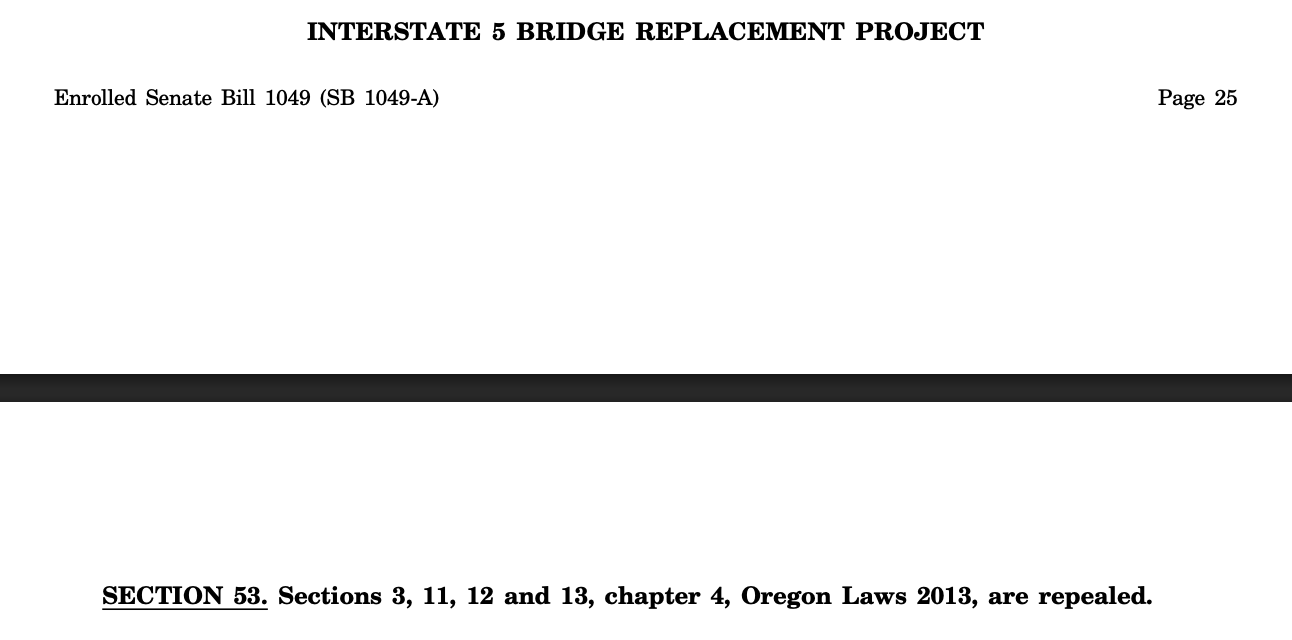Unaccountable: Even when the legislature enacts “sideboards” to prevent costly ODOT mistakes, the agency easily evades or repeals them
The big buzzword in Salem, when it comes to addressing the Orgon Department of Transportation’s huge financial problems is “accountability.” Somehow the legislature will enact some magic gimmick–like changing the who appoints the ODOT director, or requiring audits, or having an oversight committee, and this will make cost overruns disappear.
Sadly, there’s imply no evidence ODOT will be held to account. We know that because in the past when the Legislature has tried to impose measures to limit liability and assure accountability, ODOT has evaded them, or convinced the Legislature to simply repeal them. We’ve already itemized how all of the supposed accountability measures have been tried, and failed, including audits, an oversight committee, changing the director’s boss, a “dashboard”, creating a special office to manage megaprojects, and even a management gimmick called “RACI.” The claims of accountability ring hollow.
Perhaps most importantly, the Legislature has never given them the teeth they need to actually work. In 2017, it mandated that the Legislature form a special committee on mega-projects, but the committee sunsetted without filing a legally required report. And even when they impose “conditions” on approval designed to assure accountability, the agency gets around them.
In 2013, the Legislature imposed a tough set of conditions to protect Oregon from excessive costs on the Columbia River Crossing (since re-branded as the Interstate Bridge Replacement). The conditions, or “sideboards” were designed to make sure that the agency was fully accountable each step of the way. But a decade later, in the closing days of the 2023 session, the agency persuaded the legislature, with no public debate, to simply repeal all those conditions.
Now, what was once a $4.8 billion dollar project–and which more recently has been pitched as costing as much as $7.5 billion–promises to cost much, much more, and there’s nothing in place to prevent ODOT from committing Oregon to a hugely expensive liability.
As they seek to make ODOT “accountable,” legislators would be well advised to look in the rearview mirror to see how well past measures have worked.
In reality, on the treacherous and winding road that is the ODOT fiscal crisis, there are no guard-rails to prevent Oregon from being driven off a cliff.
Unaccountable ODOT: Tearing down the sideboards
In 2023, ODOT wanted authority to spend money on the massive Interstate Bridge Project; but the 2013 Oregon Legislature put in place a series of statutory conditions that had to be met before the state could issue any debt for the I-5 bridge replacement project. In legislative parlance, these conditions are called “sideboards,” but you can think of them as guardrails that are designed to keep things from running off the road too far. These sideboards were written into the law the legislature passed to guarantee ODOT accountability for the costly (and risky) Columbia River Crossing project. We know from the agency’s frequent statements that it insists on following the law–it has claimed it has to layoff employees, because “legal restrictions” preclude the agency from spending money earmarked for capital construction on staff. But in the case of the Interstate Bridge Project, ODOT didn’t find these legal restrictions to be much of a barrier.
In the waning days of the 2023 legislative session–with virtually no public discussion–ODOT sought and obtained an amendment to an un-related bill that stripped away every one of these statutory sideboards.
SB 1049 of the 2023 legislative session (an omnibus state financial administration bill) was, in the last days of the legislative session, amended to add Section 53 which provided:
- capped the total cost of the project
- required federal funding be in hand in advance of construction
- required Washington’s contribution to be fully committed
- required US DOT to submit a “full funding grant agreement” of at least $850 million for the transit portion of the project
- required an investment grade analysis and Treasurer’s approval of the project’s financial plan before bonds could be issued.
“The Speaker is comfortable with HB 2800, as amended, because there are sideboards and safeguards that control the timing of spending and limit costs. The amended bill prohibits the sale of bonds unless the Treasurer has approved an investment grade analysis of toll revenues and a comprehensive financing plan that shows sufficient revenue to pay for the initial phase of the project,” Kotek’s spokesman, Jared Mason-Gere wrote in an email. (Emphasis added).
(4) The Department of Transportation may not request and the State Treasurer may not issue any bond to finance the Interstate 5 bridge replacement project unless:(a) No later than September 30, 2013, the State of Washington has appropriated, authorized or committed sufficient funds to:(A) Satisfy the United States Department of Transportation requirement for a proposed full funding grant agreement application; and(B) Meet the requirements of the finance section included in the project’s Final Environmental Impact Statement published on September 11, 2011, and endorsed by the Federal Transit Administration and the Federal Highway Administration in the record of decision dated December 7, 2011;(b) The United States Department of Transportation has submitted a full funding grant agreement application, in an amount of at least $850 million of Federal Transit Administration funds, for congressional review;(c) The State Treasurer has participated in and approved the findings of an investment grade analysis of toll revenues associated with the project’s application for a loan from the Federal Highway Administration’s Transportation Infrastructure Finance and Innovation Act program, and provided for ongoing financial analysis of the project;(d) The State Treasurer has reviewed and approved a comprehensive financing plan for the project, after making written findings that there are sources of funds committed by contract or law or otherwise obligated that are reasonably expected to be available and that will provide sufficient cash flows to pay the estimated costs of the initial phase of the project described in the full funding grant agreement without revenues from borrowings in addition to those described in subsection (3) of this section; and(e) The United States Coast Guard has issued a general bridge permit for the main channel of the Columbia River for the project.


